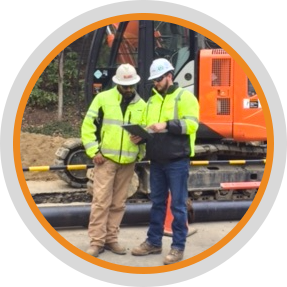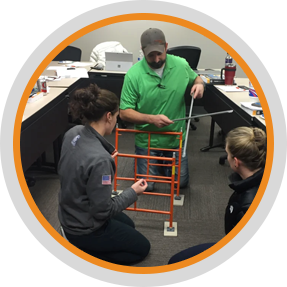Safety Training

Competent Person Training
- Confined Space
- Fall Protection
- Trenching and Excavation
- Silica
- Scaffolding
Competent Person Training
- CPR/First Aid
- Aerial Lift and Platform Lift Operation
- Powered Industrial Truck Operation
- Qualified Rigging and Signal Person
- 8, 24, 40 Hour Hazwoper (Hazardous Waste Operations and Emergency Response)

Industry Specific Training
- OSHA 10 Hour General Industry
- OSHA 30 Hour General Industry
- OSHA 10 Hour – Construction
- OSHA 30 Hour – Construction
- MSHA Part 46 and 48 Annual
- MSHA Part 46 and 48 Refresher

Supervisory Management Training
- Accident Investigation (Root Cause Analysis)
- Audits and Inspections
- Behavior-Based Safety
- Developing a Safety Committee
- Improving Safety Culture
- Job Safety Analysis/Job Hazard Analysis
- Methods and Techniques of Training
- Safety Leadership
- Supervisor Roles and
Responsibilities

Awareness Training
- Bloodborne Pathogens
- Confined Space Attendant, Entrant and Rescue
- Electrical Safety
- Environmental Awareness: SPCC
- Excavation and Trenching
- Fall Protection
- Fire Prevention and Protection
- Lifting and Material Handling Awareness
- Hazard Communication
- 8, 24, 40 Hazwoper (Hazardous Waste Operations and
Emergency Response)
- Hearing Conservation
- Ladder Safety
- Lockout/Tagout
- Machine Guarding
- Personal Protective Equipment
- Recordkeeping and Documentation
- Respiratory Protection
- Lead and Asbestos
- Scaffolding
- Steel Erection (29 CFR 1926, Subpart R)
- Walking/ Working Surfaces

Competent Person Training
- Confined Space
- Fall Protection
- Trenching and Excavation
- Silica
- Scaffolding
Competent Person Training
- CPR/First Aid
- Aerial Lift and Platform Lift Operation
- Powered Industrial Truck Operation
- Qualified Rigging and Signal Person
- 8, 24, 40 Hour Hazwoper (Hazardous Waste Operations and Emergency Response)

Industry Specific Training
- OSHA 10 Hour General Industry
- OSHA 30 Hour General Industry
- OSHA 10 Hour – Construction
- OSHA 30 Hour – Construction
- MSHA Part 46 and 48 Annual
- MSHA Part 46 and 48 Refresher

Supervisory Management Training
- Accident Investigation (Root Cause Analysis)
- Audits and Inspections
- Behavior-Based Safety
- Developing a Safety Committee
- Improving Safety Culture
- Job Safety Analysis/Job Hazard Analysis
- Methods and Techniques of Training
- Safety Leadership
- Supervisor Roles and
Responsibilities

Awareness Training
- Bloodborne Pathogens
- Confined Space Attendant, Entrant and Rescue
- Electrical Safety
- Environmental Awareness: SPCC
- Excavation and Trenching
- Fall Protection
- Fire Prevention and Protection
- Lifting and Material Handling Awareness
- Hazard Communication
- 8, 24, 40 Hazwoper (Hazardous Waste Operations and
Emergency Response)
- Hearing Conservation
- Ladder Safety
- Lockout/Tagout
- Machine Guarding
- Personal Protective Equipment
- Recordkeeping and Documentation
- Respiratory Protection
- Lead and Asbestos
- Scaffolding
- Steel Erection (29 CFR 1926, Subpart R)
- Walking/ Working Surfaces
Is your current health and safety management reactive? Do you handle things as they happen? Do you react to problems when they occur?
Would you say your’re more proactive? You look forward and plan for what could be around the corner. You try to eliminate problems before they happen.
But what’s the difference between proactive and reactive health and safety management? Should you use one, or the other, or both?
Proactive health and safety measures
Proactive safety management is all about keeping ahead of the game, resolving any issues before an incident or an accident occurs.
Proactive safety measures include:
Inspections
Interviewing
Audits
Monitoring performance
Monitoring behaviour
Checking procedures
Safety sampling
Proactive safety inspections, regular auditing, ongoing training, near-miss reporting and active supervision will all form part of a proactive safety management structure. An accident hasn’t happened yet. You’re looking for areas where you could make improvements. Tasks or activities that could be safer.
In the short term, proactive safety measures can seem more expensive. You are spending time and money on health and safety before any safety or health issues may have developed.
But you are also spending time and money on your terms. There’s no emergency. No one is hurt. No HSE inspectors lurking around. No insurance companies are on the phone.
The benefits of a proactive safety regime are that it will enforce a positive safety culture, help to prevent accidents from occurring, and improve health and safety budgeting.
Is your current health and safety management reactive? Do you handle things as they happen? Do you react to problems when they occur?
Would you say your’re more proactive? You look forward and plan for what could be around the corner. You try to eliminate problems before they happen.
But what’s the difference between proactive and reactive health and safety management? Should you use one, or the other, or both?
Proactive health and safety measures
Proactive safety management is all about keeping ahead of the game, resolving any issues before an incident or an accident occurs.
Proactive safety measures include:
Inspections
Interviewing
Audits
Monitoring performance
Monitoring behaviour
Checking procedures
Safety sampling
Proactive safety inspections, regular auditing, ongoing training, near-miss reporting and active supervision will all form part of a proactive safety management structure. An accident hasn’t happened yet. You’re looking for areas where you could make improvements. Tasks or activities that could be safer.
In the short term, proactive safety measures can seem more expensive. You are spending time and money on health and safety before any safety or health issues may have developed.
But you are also spending time and money on your terms. There’s no emergency. No one is hurt. No HSE inspectors lurking around. No insurance companies are on the phone.
The benefits of a proactive safety regime are that it will enforce a positive safety culture, help to prevent accidents from occurring, and improve health and safety budgeting.
Instructor-Led Training
Quality Training
At Trinity, we pride ourselves on the quality of our training. We deliver well-prepared, engaging training sessions that are designed for students to take an active part in the learning experience. We are always looking for new ways to engage participants through concept demonstrations, hands-on activities, and case study materials. Safety doesn’t have to be boring!
Lecture-based Training
Lecture-based training is effective when it is led by experienced safety professionals who know how to keep an audience interested. Our Safety Facilitators have trained in front of groups both small and large, with participants of all experience levels. We tailor the training to our audience to make sure we are speaking the language of your organization
